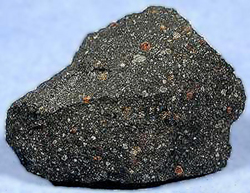Meteorite discovered 40 years ago found to contain 14,000 compounds
After landing outside a small town in Australia more than 40 years ago, scientists now have identified 14,000 different compounds in the Murchison meteorite—a meteorite in the carbonaceous chondrites family that is thought to predate the Sun and can offer insight into the Solar System’s early conditions.
The results, published in the current issue of the Proceedings of the National Academy of Sciences, show that, while not actually a sign of life, the organic molecules contained in the meteorite are the building blocks of life on Earth.
And the multitude of these compounds suggests the primordial Solar System probably had a higher molecular diversity than present-day Earth.
As lead researcher Philippe Schmitt-Kopplin from the Institute for Ecological Chemistry in Neuherberg, Germany said in a BBC article:
We are really excited. When I first studied it and saw the complexity, I was so amazed. Having this information means you can tell what was happening during the birth of the Solar System. Meteorites are like some kind of fossil. When you try to understand them you are looking back in time.
Schmitt-Kopplin and colleagues used ultra-high-resolution mass spectrometry to identify the compounds, which include 70 amino acids. The measurements they took, however, represent only a fraction of potential organic chemicals: the scientists estimate there could be millions.
Says Schmitt-Kopplin in the BBC article:
We were very conservative in our calculations and interpolation. We have to crush a few milligrams from the core of the meteorite to enable the extractions with solvents and thus we only see the extractable fraction.
Read more at Discovery News and Wired Science.
Schmitt-Kopplin, P., Gabelica, Z., Gougeon, R., Fekete, A., Kanawati, B., Harir, M., Gebefuegi, I., Eckel, G., & Hertkorn, N. (2010). High molecular diversity of extraterrestrial organic matter in Murchison meteorite revealed 40 years after its fall Proceedings of the National Academy of Sciences, 107 (7), 2763-2768 DOI: 10.1073/pnas.0912157107
